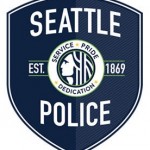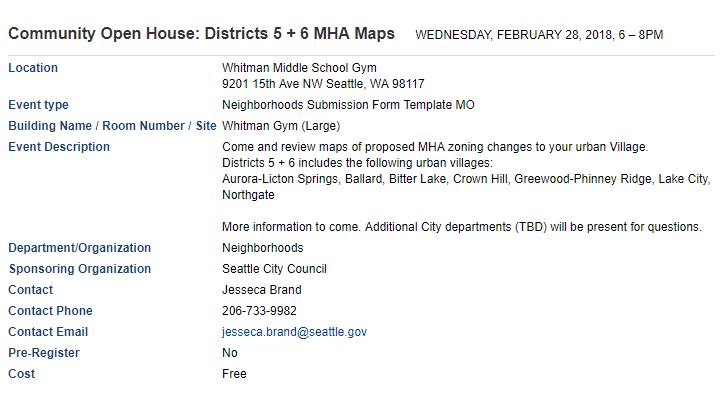|
||||||||||||||||||||||||||||||||||||||||||
|
No vehicle may travel further than three hundred feet within the lane. A signal, either electric or manual, for indicating a left turn movement, shall be made at least one hundred feet before the actual left turn movement is made.
Seattle is using a data-driven policing method, where data is compiled, analyzed and used to deploy officers throughout the city and within the precincts as needed. A question came up as to where the data comes from. Crime reported by contact with an officer on the street, by calling 911 and by on-line reporting all goes into the crime database that the Crime Analysis Unit uses. If you want to make totally sure your call or on-street contact is logged, ask for an event number. The meeting minutes are here.
|
||||||||||||||||||||||||||||||||||||||||||
| Lake City Community Center Rebuild | $5,000,000 |
| Hubbard Homestead Park neighborhood planning | $35,000 |
| Sound Generation: Expansion of the Lake City and Northgate “Senior Center Without Wall” | $60,000 |
| Aurora Commons: Expansion of outreach and drop-in services | $60,000 |
| Sweetened Beverage Tax – Increase funding for food banks* | $369,910 |
| Law Enforcement Assisted Diversion (LEAD) Expansion to SPD North Precinct | $750,000 |
*Some of this funding will also be used to support food banks in other Council Districts
Citywide/Multi-District – New and Continuing Investments = $11,100,000
| Worker Retention and Job Security Initiative | SLI |
| Chief Seattle Club pre-design funds for future affordable housing project | $100,000 |
| Maintain commitment to North Precinct Police Station | $11,000,000 |
Collaborations = $1,875,000 (these investments include programs and projects that were sponsored by other Councilmembers and that require investment from other government and/or nonprofit partners)
| Community Health Engagement Locations | $1,300,000 |
| Youth Opportunity Center and Housing Project | $500,000 |
| Home and Hope – Housing pre-development (Northgate & Citywide) | $75,000 |
This budget also includes funding for pedestrian improvements throughout our community through the Move Seattle Vision Zero initiative:
| Project | Spend Plan | Projected Design | Projected Construction |
| Sand Point Way Safety Corridor | $970,000 | 2018 | 2019 |
| Aurora Ave N Safety Corridor (in partnership with WSDOT) | $580,000 | 2017-2019 | 2018-2019 (multiple phases) |
| Lake City Way Intersection Improvements | $500,000 | 2017-2019 | 2020 |
Plan for one gallon (1 gallon = 4 quarts or ~4 liters or 128 oz or 16 eight-oz bottles) per person per day: Drink ½ gallon of water per day—more if you are in a hot climate, sick, or pregnant. Use the rest for hygiene. Only use water that has been
disinfected for drinking, cooking, making any prepared drink, washing dishes, and brushing teeth. Below are five ways of ridding the water of pathogenic bacteria, viruses, and protozoa. Water that has been contaminated with chemicals cannot be purified and should not be used.
ACCESS
1. Store 10-14 day supply of water, 1 gallon per person per day. Don’t forget water for pets. You can either:
Store commercially bottled water and/or
Store your own tap water
Use 2-liter soda bottles. Rinse well in clean water. Do not use plastic jugs that have had milk or milk products in them.
Fill with tap water. Date the bottle. Store the bottle.
Keep for 6 months then repeat procedure.
2. Access water from your hot water heater. Now, before the disaster, make sure that the water heater is secured to the wall. If it falls, the water will be lost. (See separate handout on accessing water from the hot water heater.) A 40-
gallon hot water heater will supply a family of 4 for ~10 days.
PURIFY
3. Use bleach.(Parts of this section were adapted from the Environmental Protection Agency, EPA,
https://www.epa.gov/ground-water-and-drinking-water/emergency-disinfection-drinking-water)
Another source of fresh water could be Lake Washington or Lake Union or Lake Sammamish. Water from rain barrels can also be used, although generally, flowing water is a better choice than still water. Do not use water
that is salty—from Puget Sound or the Pacific Ocean. Avoid grossly contaminated water.
Disinfection does not work as well if water is cloudy or colored. If there are particles in the water, let the water sit for 30 minutes so particles can settle to the bottom. Next strain the water using a cloth or paper towel, or a coffee filter, or an article of clothing, like socks or hosiery, into a clean container.
For each gallon of water, add chlorinated bleach (like Clorox), 8 drops of regular-strength bleach or 5 drops of concentrated bleach. Accurately measuring drops may be difficult without an eye dropper, so you can:
Use a straw—put straw in bleach; cover end of straw with your thumb; remove straw from bleach; slowly release thumb so that individual drops fall and are collected into a separate container; add those drops of bleach to the water container. Note: The size of the straw may alter drop size.
Use a 1/8 teaspoon measure: Fill the 1/8 teaspoon nearly full to equal 8 drops; fill it about half full to equal 5 drops. If your smallest measuring spoon is ¼ teaspoon, then estimate a half amount for directions for 1/8 teaspoon. (1 milliliter = 15 drops; 1 teaspoon = ~ 5 milliliters; 1 teaspoon = 75 drops; 1/8 teaspoon = ~9
drops).
If you have neither straw nor measuring spoon, estimate as closely as you can and go by smell and taste.
Allow treated water to stand for 30 minutes. Properly treated water has a slight chlorine odor. If there is no chlorine odor, add the same amount of bleach wait 15 minutes, and recheck for chlorine odor. If the chlorine taste is too strong, pour the water from one clean container to another and let it stand a few hours before use.
4. Use commercial products. Travel or outdoor recreation stores have iodine tablets, ultra-violet purifiers, pump- and gravity-filters, all of which would be useful in an emergency kit. Follow specific instructions for each.
5. Boil water if you have a power source. If the water is cloudy, or if there is particulate matter, filter it first. Bring to a rolling boil for at least one minute. Above 5,000 feet, boil the water for 3 minutes. Let water cool naturally and store
in clean, covered containers. To improve the flat taste of boiled water, add a pinch of salt, or pour it from clean-container to clean-container several times. (From https://www.epa.gov/ground-water-and-drinkingwater/emergency-disinfection-drinking-water)
ACCESSING WATER FROM YOUR WATER HEATER
Step 1: Ensure the water in the tank stays clean. If you haven’t already shut off
water to the house, do that now. If you can’t shut off water to the entire house, at
least close the valve that allows water to enter the water heater (the supply valve).
This will keep potentially contaminated water from sullying the water in your tank.
Step 2: Cut off power to the tank.
– ELECTRIC water heater: flip the breaker supplying electricity to the appliance.
Rationale… you’re going to drain the tank and you never want to run this appliance without water in it.
– GAS water heater: shut off the gas to the tank. Rationale… if you are eyeballing
your hot water tank for drinking water you probably can’t afford a hot shower.
Step 3: Allow the water to cool. This will take hours!
Step 4: Attach a hose. Near the bottom of the tank is the drain. Attach a washing
machine hose or garden hose to it. Do NOT open the valve yet!
Step 5: Break the vacuum. Water won’t come out of the tank until air is allowed
in. Disconnect the hot water line at the top of the tank. If you can’t get the line
off, turn on a hot water faucet in the house to allow air into the tank.
Step 6: Collect the water. Open the valve at the bottom of the tank and collect
the water in a clean storage container. The first few gallons may contain rust
and/or sediment. Let it settle before using it.
Step 7: Treat the water. Add bleach, stir, and let the water stand for 30 minutes.
– Regular bleach (5.25%) – add 8 drops per gallon.
– Concentrated bleach (8.25%) – add 5 drops per gallon.
** BEFORE disaster hits, mark the supply valve. Run the hot water from any sink.
Touch the two pipes attached to the top of the water heater. The “supply” line will
be the colder one. Mark the valve as “supply”. This will be the one to close in an
emergency so that contaminated water will not go into the tank as you drain the
clean drinking water that is stored in it.
**Allow the tank to fill completely before restoring power to the water heater.
Hosted by VPSLink.com
Powered by WordPress & Atahualpa








